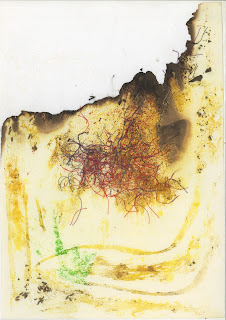 |
| Zo série Města vnitrozemí, 2012/2013 |
Ďalšou autorkou, ktorej kresby uvedieme v druhom čísle časopisu je mladá česká umelkyňa Dita Kaplanová. Dita žije a tvorí v Bratislave. Kľúčovými
témami jej subtílnych kresieb sú čas a pamäť. Kresba slúži
ako graf, ktorý zachytáva najjemnejšie záchvevy a stavy autorkinej mysle. Jednotlivé záznamy sú Kaplanovej intímnym archívom, ktorý jej
umožňuje vrátiť sa k prežitým udalostiam, prehodnotiť ich,
znovu-objavovať, odkrývať, či zničiť práve prostredníctvom
kresby.
Dita o svojej tvorbe:
V
mojí tvorbě pracuji hlavně s fenoménem času a paměti. Času žitého, plného emocí a života. Paměť je pro mě archivem vzpomínek a zážitku. Formálně jsou mými výstupy hlavně kresby a taktéž minimalistické animace
z nich.
V sérii Města vnitrozemí pracuji s tématem autoportrétu v obecné rovině až lidských portrétů, a to žilního oběhu člověka.
Název a téma je do jisté míry inspirována knihou Vášeň od Jeanette Winterson. Polemizuji zde nad psychickými stavy jedince, které vizualizuji seizmografickými grafy.
 |
| Zo série I am starting to see behind the corner, 2012/2013 |
 |
| Zo série I am starting to see behind the corner, 2012/2013 |
Another author who’s drawings
will be presented in the second edition of the magazine is the young Czech
artist Dita Kaplanova. She lives and works in Bratislava. The key elements of her subtle
drawings are time and memory. Her drawings serve as graphs capturing the finest
vibrations and states of the author’s mind. Individual captures are her
intimate archives which allow her to recall the moments she has experienced, to
re-evaluate, re-discover, uncover or to obliterate them through drawings
themselves.
Dita about her work:
My work is mainly focused on the
phenomenon of time and memory. Time lived, full of emotions and teeming with
life. My memory serves me as an archive of reminiscences and experiences. Formally,
my outputs are mainly drawings and their minimalist animations. In a series
called Inland Cities I elaborate the theme of self-portraits in general as well
as human portraits and their venous circulations.
The title and topic are to some
extent inspired by the book The Passion by Jeanette Winterson. My artwork is a controversy over individuals’
mental states, visualized by seismographs.
 |
| Zo série Města vnitrozemí, 2012/2013 |
 |
| Zo série I am starting to see behind the corner, 2012/2013 |









.jpg)














